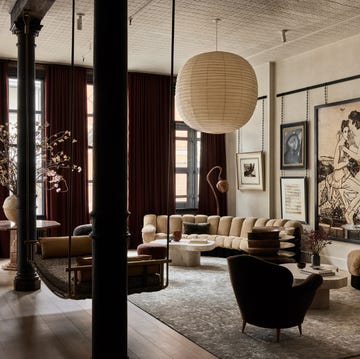In a typical London Victorian terraced flat, the problems are always the same: proximity to noise and pollution, narrow corridors and a lack of light in the basement. This project aimed to transform this type of space into a warm, restorative retreat in the heart of the city.
Named the Wave Residence (an amalgamation of the owner’s names), it’s located in leafy Canonbury – a neighbourhood dominated by Victorian and Edwardian terraces, many of which are subdivided into flats. The area is popular with young couples and families thanks to its proximity to the City, the West End and Stoke Newington. It’s elegant, but densely packed and there is a lack of space and quiet.
The flat’s owner is Winnie Tam – founder of the architectural and interior design firm fourteen a.m. Redesigning her own home was the perfect opportunity to showcase her design philosophy, which centres on creating sanctuaries for city dwellers. She says ‘We both work in the city and are attracted by all the culture and opportunity on offer, but longed for a calm place where we could reconnect with nature and recharge.’
What's everyone reading?
She gave herself a clear brief: to banish the typical ‘basement feeling’ of the lower-ground floor and create an atmosphere where she and her partner could feel calm. The space also needed to be flexible enough to accommodate a home office and a growing family.
The constraints of the plot required some imaginative thinking, though. The flat is in a conservation area and has a tiny garden, so the new infill extension is only seven square metres. But what’s been done with that modest amount of space is remarkably effective.
The flow and use of space has completely altered, with the wall between the entrance hallway and living room opened up to create a more welcoming feel for visitors. The new lower-ground layout is now divided into two halves: one houses the main bedroom with its own ensuite and walk-in wardrobe, while the other has a home office, tea room (which can be turned into a guest bedroom) and shower room.
Opening onto the garden through bifold windows, the office also serves as a morning yoga space. All this was made possible by relocating the bathrooms to the centre of the home – a decision that threw up some challenges when it came to getting the drainage to the middle of the house.
The compact site meant every inch of space had to work hard. Storage and joinery were designed in a ‘hidden’ way to reduce visual distractions and walls were finished with clay plaster – a time-consuming job that required skilled craftsmanship, but which established the desired atmosphere.
Winnie strove to minimise the variety of materials used to reduce the amount of visual stimulation. It worked: ‘Visitors are impressed by the “intense calm” they feel as soon as they walk through the door,’ she says. ‘Through widening openings upstairs and bringing light downstairs by converting steps into open treads, the space now feels very comfortable.’
Materials were chosen to evoke nature: jute carpet, Tadelakt and handmade terracotta tiles in the bathrooms, a glowing moon-like travertine wall light and iroko timber everywhere from doorways to stair louvres and even framing chimney vents.
She collaborated with Other Projections to fill the rooms with pieces that enhance and echo the themes of the scheme. A painting by Rikki Turner reflects the soft, natural patterns formed on the clay-plastered wall, Motarasu lighting is made with a thousand bamboo strips that casts ribbed shadows and Studio Furthermore’s terracotta light sculpture is formed from discarded wooden dowels and sawdust.
Winnie sums up the spirit of her reimagined home: ‘Wave Residence sets the atmosphere for us to pause, take a breath, enjoy each moment and small detail, encouraging us to have a slower pace of living, and gratitude toward ourselves and nature.’ fourteen-am.com





















